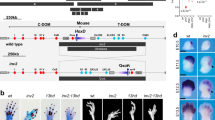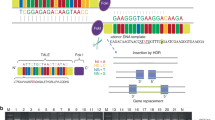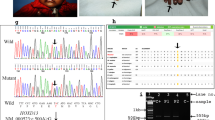Abstract
HOXD genes encode transcription factors involved in the antero-posterior patterning of the limb bud and in the specification of fingers. During the embryo development, HOXD genes are expressed, following a spatio-temporal colinearity that involves at least three regions, centrometric and telomeric to this cluster. Here, we describe a father and a daughter presenting a 3–4 hand bilateral syndactyly associated with a nystagmus. Array-comparative genomic hybridisation showed a 3.8 Mb duplication at 2q31.1-q31.2, comprising 27 genes including the entire HOXD cluster. We performed expression studies in lymphoblasts by reverse transcription-PCR and observed an HOXD13 and HOXD10 overexpression, whereas the HOXD12 expression was decreased. HOXD13 and HOXD10 overexpression, associated with a misregulation of at least HOXD12, may therefore induce the syndactyly. Deletions of the HOXD cluster and its regulatory sequences induce hand malformations and, particularly, finger anomalies. Recently, smaller duplications of the same region have been reported in association with a mesomelic dysplasia, type Kantaputra. We discuss the variable phenotypes associated with such 2q duplications.
Similar content being viewed by others
Log in or create a free account to read this content
Gain free access to this article, as well as selected content from this journal and more on nature.com
or
References
Johnson RL, Tabin CJ : Molecular models for vertebrate limb development. Cell 1997; 90: 979–990.
Kessel M, Gruss P : Murine developmental control genes. Science 1990; 249: 374–379.
Zakany J, Kmita M, Duboule D : A dual role for Hox genes in limb anterior-posterior asymmetry. Science 2004; 304: 1669–1672.
Tarchini B, Duboule D : Control of Hoxd genes’ collinearity during early limb development. Dev Cell 2006; 10: 93–103.
Goodman FR, Majewski F, Collins AL, Scambler PJ : A 117-kb microdeletion removing HOXD9-HOXD13 and EVX2 causes synpolydactyly. Am J Hum Genet 2002; 70: 547–555.
Del Campo M, Jones MC, Veraksa AN et al: Monodactylous limbs and abnormal genitalia are associated with hemizygosity for the human 2q31 region that includes the HOXD cluster. Am J Hum Genet 1999; 65: 104–110.
Svensson AM, Curry CJ, South ST et al: Detection of a de novo interstitial 2q microdeletion by CGH microarray analysis in a patient with limb malformations, microcephaly and mental retardation. Am J Med Genet A 2007; 143A: 1348–1353.
Prontera P, Bernardini L, Stangoni G et al: 2q31.2q32.3 deletion syndrome: report of an adult patient. Am J Med Genet A 2009; 149A: 706–712.
Pescucci C, Caselli R, Grosso S et al: 2q24-q31 deletion: report of a case and review of the literature. Eur J Med Genet 2007; 50: 21–32.
Boulet AM, Capecchi MR : Duplication of the Hoxd11 gene causes alterations in the axial and appendicular skeleton of the mouse. Dev Biol 2002; 249: 96–107.
Kantaputra PN, Klopocki E, Hennig BP et al: Mesomelic dysplasia Kantaputra type is associated with duplications of the HOXD locus on chromosome 2q. Eur J Hum Genet 2010; 18: 1310–1314.
Sheth R, Bastida MF, Ros M : Hoxd and Gli3 interactions modulate digit number in the amniote limb. Dev Biol 2007; 310: 430–441.
Dlugaszewska B, Silahtaroglu A, Menzel C et al: Breakpoints around the HOXD cluster result in various limb malformations. J Med Genet 2006; 43: 111–118.
Cho TJ, Kim OH, Choi IH et al: A dominant mesomelic dysplasia associated with a 1.0-Mb microduplication of HOXD gene cluster at 2q31.1. J Med Genet 2010; 47: 638–639.
Miyake N, Chilton J, Psatha M et al: Human CHN1 mutations hyperactivate alpha2-chimaerin and cause Duane's retraction syndrome. Science 2008; 321: 839–843.
Author information
Authors and Affiliations
Corresponding author
Ethics declarations
Competing interests
The authors declare no conflict of interest.
Rights and permissions
About this article
Cite this article
Ghoumid, J., Andrieux, J., Sablonnière, B. et al. Duplication at chromosome 2q31.1-q31.2 in a family presenting syndactyly and nystagmus. Eur J Hum Genet 19, 1198–1201 (2011). https://doi.org/10.1038/ejhg.2011.95
Received:
Revised:
Accepted:
Published:
Issue date:
DOI: https://doi.org/10.1038/ejhg.2011.95
Keywords
This article is cited by
-
Fryns type mesomelic dysplasia of the upper limbs caused by inverted duplications of the HOXD gene cluster
European Journal of Human Genetics (2020)



